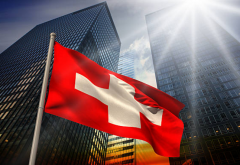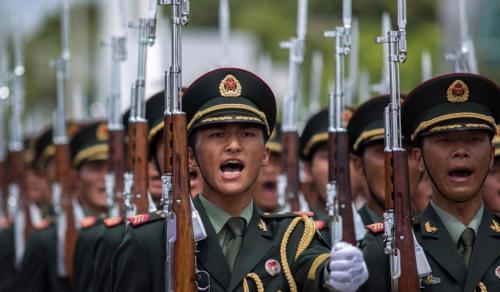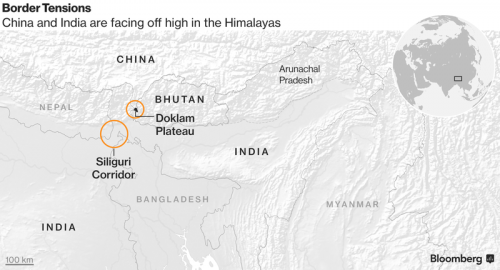Steve Bull's Blog, page 1341
August 11, 2017
Central Banks Are Hiding the True Price of Risk

If you invest your money, you will have to deal with numerous risks. For instance, if you buy a bond, you run the risk of the borrower defaulting or being repaid with debased money. As a stock investor, you face the risk that the company’s business model will not live up to expectations, or that it, at the extreme, will go bankrupt. In an unhampered financial market, prices are formed for these and other risk factors.
For instance, a bond with a high default risk will typically carry a high yield. The same goes for debt denominated in an unsound currency. Stocks of companies that are deemed risky tend to trade at a lower valuation level than those considered low risk. All these risk premiums, if determined in the unhampered market, constitute a portion of an asset’s price, be it a bond or a share. They play a vital role in the way capital is allocated in an economy.
Risk premiums are meant to compensate investors for the risk of losses resulting from adverse developments. If you buy a stock at a depressed price relative to the firm’s earnings power, it tends to reduce your downside (while offering the chance of great gains). At the same time, risk premiums increase investors’ cost of capital. This, in turn, discourages them from engaging in overly risky investments.
Decline in risk premiums:

In other words, risk premiums determined in an unhampered market align the interests of savers and investors. Of course, one cannot be sure that ex ante risk premiums are always correct. Sometimes it turns out that risks were overestimated, sometimes they were underestimated. However, the unhampered market is still the best and most efficient means to determine the price of risk.
…click on the above link to read the rest of the article…
Guam Issues “Preparing For An Imminent Missile Threat” Guide: “Do Not Look At The Fireball”
Guam Homeland Security issued a new fact sheet Friday, which the agency says will help residents prepare for an imminent missile threat.
The information was released following this week’s threat by North Korea to launch a missile attack against Guam. The advice includes tips such as:
“Do not look at the flash or fireball – It can blind you” and
“Take cover behind anything that might offer protection.”
“Lie flat on the ground and cover your head. If the explosion is some distance away, it could take 30 seconds or more for the blast wave to hit,” the sheet states.
During a press conference at Adelup late Friday afternoon, USA Today reports that Gov. Eddie Calvo told reporters that the threat level remains the same and that the island is “safe and sound.”
“There are no changes,” Calvo said.
“Everyone should continue to live their lives.”
While the governor said there’s no imminent threat to the island, he said families should still be prepared any situation,including inclement weather, and establish a family emergency plan.
August 8, 2017
China Threatens “Small Scale Military Operation” To Remove India From Bhutan Border
In the latest escalation between two nuclear powers, China has turned the war threat amplifier up to ’11’ by threatening India (in an article published a Chinese state-controlled newspaper) that it could conduct a “small-scale military operation” to expel Indian troops from a contested region in the Himalayas.
The latest standoff started in June, after Chinese troops started building a road on a remote plateau, which is disputed by China and Bhutan. Indian troops countered by moving to the flashpoint zone to halt the work, with China accusing them of violating its territorial sovereignty and calling for their immediate withdrawal.
China then added a large number of troops to the region:
“The crossing of the mutually recognised national borders on the part of India… is a serious violation of China’s territory and runs against the international law,” Chinese defence ministry spokesman Wu Qian told a press conference quoted by AFP, adding that “the determination and the willingness and the resolve of China to defend its sovereignty is indomitable, and it will safeguard its sovereignty and security interests at whatever cost.”He also said that “border troops have taken emergency response measures in the area and will further step up deployment and trainings in response to the situation,” without giving any details about the deployment.
Then it escalated with a Chinese Ministry of Defense official now warning explicitly that Indian troops must leave the contested area if they do not want war.
And now, it has become more specific, with The Independent reporting that Chinese and Indian media have taken a strident approach, with an article in the Chinese state-owned Global Times quoting a research fellow at the Institute of International Relations of the Shanghai Academy of Social Sciences saying China is preparing to initiate a “limited war” to push Indian soldiers out of the area.
…click on the above link to read the rest of the article…
Something is Broken in the UK Intellectual Sphere.
The BBC did some kind of educational cartoon on Roman Britain and represented “diversity” in terms of someone looking African in the show as representative of “diversity” at the time. The BBC was effectively applying quotas retroactively (I mean, really retroactively). Any dissent from the statistical errors made by the politically correct police is treated as apostasy. Effectively, scholarship is dead in the U.K.

What was meant to be a “typical” of Roman Brittain by the BBC: flowing quotas of political correctness backward in time.
Representativeness heuristic. The picture was portrayed as representative (playing on the representativeness/availability heuristic in the minds of children). Some people backtracked later by saying it is was not common but not impossible, which is where I shout “BS!” (More technically, calling events that fall in the tails of the distribution, beyond 2 standard deviations “typical” and, as Mary Beard describe it “accurate” is a lunacy. “Typical” is within one STD).
Anecdotal vs Statistical. The backup is mostly anecdotal from cherry picked stories. We find nothing beyond traces of sub-Saharan genes in areas where Roman legions were located (France, Gaul, and even Spain, where most of it came much later from the Arab trade) — but we find genes of other Roman occupiers. Show the picture to a French or Italian person and tell him “this is the typical…” and wait for the insults.
Fuzzy classification. Even the researchers who deal with physical remains miss the point that people from North Africa looked no different from Spaniards, S. Italians, and Greeks. Punics/Phoenicians we now know, looked Canaanite, just like Southern Europeans. Berbers looked like mountain berbers today. So representing “diversity” should focus on the difference between locals and Romans (Northern European vs Mediterranean), not within Romans (in other words, Butter vs Olive Oil ).
…click on the above link to read the rest of the article…
The Madhouse

In the late 17th century, we British decided that, as a humanitarian effort and public service, we’d collect up all the people from the towns and countryside who were bonkers and confine them in institutions, so that society could be protected from them.
As so often proves the case, the idea of a collective solution to an individual problem is doomed to failure from the start.
There are many problems with madhouses. First, they need funding and, of course, the entity that receives the funding is likely to prefer skimming off whatever they can, rather than spending it on the inmates. Second, the sort of people who apply to become staff are often not the most desirable, and in fact are often dangerous. Third, one madman might be a social problem, but what happens when you throw them all in together? Are conditions likely to make them less mad or more mad? (I would suggest the latter.)
When I was a teenager, I had the dubious pleasure of visiting a state-run madhouse—the maximum-security ward, where all the most violent inmates were kept.
I’d been asked to visit a short-term inmate named Billy, who’d been committed to the mental institution for a month as punishment for a petty crime. My purpose was to hopefully raise his spirits, but my one visit there provided me with insight that I couldn’t have gained otherwise and has stayed with me for life.
I was taken through several layers of security before being led through a series of heavy steel doors into a large room. There were tables and chairs in the middle and beds along the walls. About fifteen men were talking congenially in small groupings.
…click on the above link to read the rest of the article…
Can Switzerland Survive Today’s Assault on Cash and Sound Money?

“Switzerland will have the last word,” wrote Victor Hugo in the late 19th century. “It possesses one of the most perfect forms of government in the world.” A contemporary of his, Frederick Kuenzli, a scholar of the Swiss Army, boasted: “No purer type of Republican ideals, no more fixed and devoted adherence to those ideals can be found in all the world than in Switzerland.”
On many levels, there is reason to believe that, indeed, Switzerland remains a unique oasis of rationality and intelligence in the ocean-wide bloodbath that is contemporary Western fiscal and social self-sabotage. On the other hand, there is the Swiss National Bank — the central bank — that oddly appears to be encouraging the same monetary policy dance-with-death that has tripped up the country’s masochistic neighbors. How viable yet is the Swiss element in that which we still admire as the nation of Switzerland? First the good news:
Direct democracy is alive and kicking: No mere opinion poll, the power and vibrancy of the referendum — one that can be launched by any local who can gather 100,000 signatures in support — constitutes one of the most impressive displays of true citizen-republicanism that there is. There is an upcoming vote on the Swiss Sovereign Money Initiative — a movement to obstruct financial speculation; recent referendums that were voted into law include a phasing out of nuclear energy to be replaced by renewables, and easier naturalization of third-generation immigrants.
Cash is still very much king and carrying around personal debt is a social blackmark. In fact, the love of cash has a counter-cultural dimension to it as an anti-State, anti-globalist, anti-anti-privacy gesture intended to underscore the Swiss love of freedom. The Swiss will use huge denominations (the 1000-franc note, for example) like they use pocket change to pay for everything from monthly utility bills to buying a sandwich.
…click on the above link to read the rest of the article…
The NYT’s Grim Depiction of Russian Life
As a top propaganda outlet pushing the New Cold War, The New York Times paints life in Russia in the darkest hues, but this one-sided depiction misses the reality of the increasingly vibrant country that Gilbert Doctorow sees.
Our five-week stay at our home in the Russian countryside was approaching its conclusion when I got an email from a friend in France asking me to comment on an article in The New York Times entitled “Russia’s Villages, and Their Way of Life, Are ‘Melting Away’.”

New York Times building in New York City. (Photo from Wikipedia)
The article surely met the expectations of its editors by painting a grim picture of decline and fall of the Russian countryside in line with what the author sees as very unfavorable demographic trends in the Russian Federation as a whole. The fact that his own statistics do not justify the generalization (a net population loss of a few thousand deaths over live births in 2016 for a population of 146 million) does not get in the way of the paint-by-color canvas. Nor does the author explain why what he has observed in a village off the beaten track in Northwest Russia, in precisely the still poor region of Pskov, gives an accurate account of country life across the vast territory of Russia, the world’s largest nation-state.
As the author notes, the main source of income from the land of the town he visited was – in the past – linen. That cultivation turned unprofitable and was discontinued. Consequently, the able-bodied part of the population has been looking for employment and making their lives elsewhere (a process internal migration common all over the world, including the United States).
…click on the above link to read the rest of the article…
Saving and Money–What is the Relationship?
Conventional wisdom says that savings is the amount of money left after monetary income was used for consumer outlays, implying that saving is synonymous with money. Hence, for a given consumer outlays an increase in money income implies more saving and thus more funding for investment. This in turn sets the platform for higher economic growth.
Following this logic, one could also establish that increases in money supply are beneficial to the entire process of capital formation and economic growth. (Note increases in money supply result in increases in monetary income and this in turn for a given consumer outlays implies an increase in savings).
Relation between saving and money
Saving as such has nothing to do with money. It is the amount of final consumer goods produced in excess of present consumption.
The producers of final consumer goods can trade saved goods with each other or for intermediate goods such as raw materials and services. Observe that the saved goods support all the stages of production, from the producers of final consumer goods down to the producers of raw materials, services and all other intermediate stages.
Support means that these savings enable all these producers to maintain their lives and wellbeing whilst they are busy producing things. Also, note that if the production of final consumer goods were to rise, all other things being equal, this would expand the pool of real savings and would increase the ability to further produce a greater variety of consumer goods i.e. wealth.
Note that people do not want various means as such but rather final consumer goods. This means that in order to maintain their life people require an access to consumer goods.
…click on the above link to read the rest of the article…
Bitcoin vs Gold: Peter Schiff vs Max Keiser – Who is Right? Bitcoins the New Beaver Pelts?
A major debate topic came up between Max Keiser and Peter Schiff at the Freedom Fest conference on July 19-22 in Las Vegas.: Bitcoin vs Gold.
Max Keiser is a huge proponent of Bitcoin. Peter Schiff says “These digital currencies might make fiat currencies look good. That’s how bad they are.”
The video was well produced, thanks to Stacy Hebert. It’s well worth a play in entirety.
Bitcoins the New Beaver Pelts
As noted in my clip, I think Schiff is on the right side of the debate. This is my take:
Bitcoins are the new beaver pelts of monetary transactions. For thousands of years, when available by free choice, gold has always been the currency of demand. Things like salt, cigarettes, beaver pelts, and recently Bitcoin, come and go.
The scarcity of gold is real. The scarcity of Bitcoin is artificial. It depends on trust that a human-based promise to mine more coins will be limited.
In a currency crisis, liquidity crunch, or stock market collapse, where would you rather be? If you choose Bitcoin over gold, you are not thinking clearly. You are dreaming.
Blockchain does not scale. Imagine the entire history of every transaction of any size, any place in the world, recorded on a distributed network.
Despite the hype, no one would use Bitcoin to buy a candy bar. or even a meal at McDonald’s. One might easily do that with Bitgold. Transaction costs are the difference.
Absurd proclamations and theories about the value of Bitcoin are now commonplace. This is typical of any bubble.
Transaction Fees
In regards to point number 5, Morgan Stanley says ‘Bitcoin acceptance is virtually zero and shrinking’
…click on the above link to read the rest of the article…
What slowdown? Vancouver and Toronto real estate markets still hot and unaffordable for many
Housing prices are once again climbing in Vancouver and Toronto may soon follow

Emelia Symington Fedy with her partner, Christie Watson, and two children in Vancouver — the city the family is leaving because they can’t afford to live there. (Emelia Symington Fedy)
With recent price declines in Canada’s hot real estate markets, there’s been talk of a slowdown. But, so far, it’s hardly something for prospective buyers to get excited about.
While prices did drop after the introduction of a foreign homebuyers tax in Vancouver last year, they’re once again surging to new highs.
In Toronto, both prices and sales have taken a dive since the same type of tax came into effect in April.
Some had hoped a combination of recent government rule changes making it harder to get a mortgage, higher mortgage rates and the foreign buyers tax might have a lasting effect in cooling the market.
However, Toronto home prices are still up compared to last year and some industry experts predict that, as in Vancouver, the city’s recent dip will simply be a blip.
And as long as Toronto and Vancouver’s real estate markets continue to sizzle, many people will continue to find home ownership out of reach in these cities.
‘I just don’t get to live here,” says Emelia Symington Fedy, who’s moving her family from Vancouver to Halifax because she can’t afford the high cost of housing in her beloved city. “It feels like my lover has jilted me. I’m heartbroken.”
Vancouver downturn dashed
In August 2016, the B.C. government implemented a 15 per cent tax on foreign nationals buying property in Metro Vancouver to help cool skyrocketing house prices. For a time, the tax appeared to be working.
…click on the above link to read the rest of the article…







